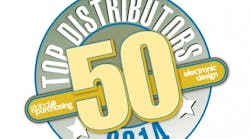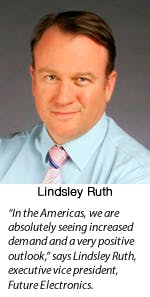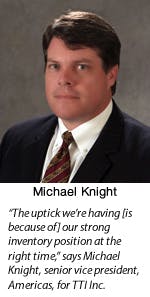For the fourth straight year, Avnet Inc. takes the top spot on Global Purchasing’s annual Top 50 Electronics Distributors list, with sales of $26.7 billion worldwide in 2013. Nearly $11 billion of that total comes from sales to customers throughout the Americas, where the global giant sells electronic components and technology solutions to a wide range of end users. Avnet and its chief rival Arrow Electronics—which ranks second on our list for the fourth consecutive year at $21.4 billion in sales—are the biggest companies on our list by far, dwarfing their nearest competitor by $13 billion and $7 billion, respectively.
Global Purchasing presents its Top 50 Electronics Distributors report each May, providing a look at the largest players in the electronics distribution market. Today’s global marketplace is reflected in the list, as most of the top 50 companies support customers around the world and more than 10% are based outside of the United States. Newcomer WPG Holdings, coming in at number 3, is based in Taiwan, for instance, and Rebound Technology Group Holdings Ltd., which debuts at number 16, is based in the United Kingdom..
“I would say 2014 is shaping up to be another record year for Future Electronics. Our investments in demand creation are paying huge dividends. Notwithstanding any global economic surprises, with the market set to grow 3% to 4% [Future should] exceed two times market growth,” says Ruth. “I think we’re looking pretty good. My outlook is fairly positive, geographically.”
A Closer Look At The Top 50
Avnet and Arrow are unique in the Top 50, as their total worldwide sales include the sale of computer/peripheral products, which are separated into both companies’ technology solutions/enterprise computing businesses. But together, the companies’ component and technology sales illustrate the size and scope of these global giants, and their presence helps set the pace of the electronics distribution channel.
Broken down, Avnet’s sales are split nearly 60-40 between component and technology business: 63% of the distributor’s sales are from electronic components and 37% are from the technology solutions side of the business. The split is the same for Arrow, with 63% of sales coming from its components business and 37% from its Enterprise Computing Solutions or ECS business. Both companies saw mid-single-digit sales increases last year—6% and 5% respectively—which is in line with the average sales increase of 7% among the top nine companies returning to the top 10 this year.
Outliers include three companies that reported double-digit sales increases—Digi-Key, number 7, at 11% growth; Mouser, number 8, at 14% growth; and DAC/Heilind Electronics, number 9, at 14% growth. All three have been pushing to expand globally in recent years. Mouser has seen considerable growth across Europe and Asia. Digi-Key launched a major expansion into Europe, the Middle East, and Africa in 2013 and followed up with a recent push to build its physical presence in Asia with a new location in Shanghai. DAC/Heilind grew considerably with its 2012 acquisition of Brazil-based distributor Kotek Eletro Electronica, which increased its business in South America.
Such growth in a slowly improving global climate is impressive, especially in an industry just getting accustomed to less than double-digit sales increases year after year. Indeed, some companies on our list reported sales declines or remained flat in 2013, underscoring the still uncertain outlook in many market sectors. Looking at the top 20 companies, Sager Electronics, number 13, and PEI Genesis, number 14, are among those reporting sales declines compared to what was reported in last year’s Top 50. Sager’s sales were down only slightly, about 1%, and PEI Genesis reported a 6.5% sales drop. Powell Electronics, number 15, was among those reporting flat sales. Flame Enterprises, number 20, also reported virtually flat sales.
Declines in government and military spending continue to hurt some firms, as do slowing conditions in some markets in Asia. The biggest of the big remain diverse enough to weather the storm, however, and are committed to their expansion strategies. Stephen Wong, president of Avnet Electronics Marketing Asia, recently commented on the company’s ahead-of-the-curve investment in inland China as one example (see Avnet Seeks Global Growth). Avnet Electronics Marketing Asia has more than 30 locations in China, many of which are in emerging cities inland.
“The potential business in the western part of China is [great],” Wong explains. “Having established there well ahead is to our advantage.”
Future’s Ruth agrees that China remains a hot target as one of the world’s largest economies, but he also points to Japan as a “great opportunity” and notes that Malaysia, Vietnam, Thailand, and India remain strong markets in the region as well. By far, the best-performing sectors for Future in Q1 are those that are a bit closer to home, however. Ruth says Future experienced a “nice uptick” in the first quarter in North America and Europe in particular, noting that the company saw one of its strongest quarters in Europe in recent history.
“In the Americas, we are absolutely seeing increased demand and a very positive outlook,” he adds, citing Mexico as potentially one of the fastest-growing markets over the next three to five years.
Strong Q1, But Cautious Outlook
Number 5 on this year’s Top 50, TTI Inc. saw a strong first quarter as well. Michael Knight, senior vice president for the Americas, points to particular strength in North America during that time. He notes that bookings and billings are up and says TTI seems to be bucking the trend toward slower growth. Inventory reductions in the channel at the end of last year—Q4 and even into the first quarter of this year—and a lengthening of lead times among some component manufacturers have proven to be a boon to TTI, which has the inventory on hand to support a resulting demand for components.
“That all favors us with our inventory position,” he says, noting that TTI maintains between the high '90s and 140 days’ sales in inventory. “The uptick we’re having [is because of] our strong inventory position at the right time.”
Knight says he maintains a cautiously optimistic outlook for the remainder of the year and notes some challenges that are likely to have a long-term effect on the industry. First is a lack of business investment throughout the channel.
“When you have three to four years of flat, you focus on productivity improvement—which means taking people out of the business, by and large,” Knight explains, noting that all of these conditions will “bite us in the future” when lead times shoot up.
Companies that are able to take a longer-term view, maintaining investments in people and technology, have an advantage, he says. Ruth agrees.
“We look at our plans and say, ‘where do we want to be in a few years?’ and then stick to that decision and investment,” Ruth says. “I don’t think we’ve ever felt as confident as we do in the programs we have today.”
Future’s FAI program, which targets new or underserved customers with a team of newly trained salespeople, is a case in point. Future re-launched the program, which ran for 15 years before being folded into the larger organization about six years ago, in North America last year. This year, Future will double its resources for the program with plans to expand it globally. New groups of sales recruits are trained throughout the year at Future’s Montreal headquarters. A group of 21 new recruits was in for training as recently as late March.
“As long as there are new customers out there, we’ll keep hiring salespeople,” Ruth says.
Declining margins are another concern, as customers continue their now built-in need for ongoing cost reduction.
“I don’t know how that lasts forever,” Knight says, adding that such pressure affects everyone’s ability to invest in their business.
Knight also points to 3D printing, new sources of supply such as Amazon and Google, and cloud computing as potential game changers for the electronics distribution channel, noting that it is “foolish to say traditional distribution will remain unchanged.” Despite the challenges, Knight says he still believes the electronic components business has its best days ahead. The fundamental need for electronics and electronic components is “just getting bigger.”
Ruth calls the growing Internet of Things market, the drive to connect more devices and processes to the Internet, a prime opportunity. Other opportunities include wearable technology, healthcare, and lighting. There is even growing opportunity in older markets such as automotive and industrial, where many distributors are seeing a pickup in business due to the adaptation and proliferation of electronics in cars, trucks, and factories.
“Our strategy is simple. We’re going to mine for gold in new markets—IoT, wearables, and so forth—while continuing to maintain a focus on traditional markets,” Ruth explains. “As another example, lighting continues to be the fastest-growing part of our business, and we entered it 14 years ago. We see a huge upside in the lighting business and will continue to see a compound annual growth rate that’s significantly higher than the semiconductor industry in general.”
The Methodology Behind Our Survey
Global Purchasing is proud to publish its fourth annual Top 50 Electronics Distributors list, compiled from nomination forms submitted during February and March. Each company in our list is ranked according to its total global sales volume, and all figures are reported in U.S. dollars. We used self-reported data from each company and verified the information against annual reports and earnings statements, where possible, as well as in follow-up interviews with some of the companies at the top of the list.
Figures for Avnet Inc., ranked first, and Arrow Electronics, ranked second, include the sale of computer products, which comprise large segments of each company’s business. Sales listed for privately held Future Electronics, fourth, are based on Global Purchasing estimates.
Figures for Allied Electronics, fifth, reflect its worldwide sales as part of Britain-based Electrocomponents plc, which also operates RS Components in Europe. The figure here is a company-provided, fiscal-year 2014 estimate for global sales. Allied’s sales were roughly $446 million in North America in fiscal year 2014, ended March 31, according to company-provided estimates. Likewise, sales for eighth place Newark element14 reflect worldwide sales as part of its parent company, Britain-based Premier Farnell.
There are some newcomers to this year’s list as well. Taiwan-based WPG Holdings debuts at number 3, with $13.6 billion in sales. This causes a shift in our list this year—especially in the top 10, which has remained largely unchanged since we started our report in 2011. Future Electronics moves down to number 4, followed by Electrocomponents plc/Allied, which edged out TTI Inc. this year and moved to number 5. TTI ranked sixth, followed by Digi-Key Corp., which maintained its place at number 7. Newark element14 dropped to number 8, followed by Mouser at ninth place and DAC/Heilind in tenth. Large independent distributor N.F. Smith & Associates, which has long held the number 10 spot, dropped to 11.
Other newcomers to the 2014 Top 50 include United Kingdom-based Rebound Technology Group Holdings Ltd., which came in at number 16, with $140 million in sales; Torrance, Calif.-based Classic Components, number 19, with $113 million in sales; San Jose, Calif.-based RFMW Ltd., number 25, with $58.5 million in sales; Marsh Electronics, number 27, based in Milwaukee, with $43.9 million in sales; Adams Magnetic Products Co., Elmhurst, Ill., at number 32, with $30 million in sales; Canada-based Diverse Electronics and New York-based Harry Krantz Co., at numbers 39 and 40, with $19.4 million and $17.5 million in sales, respectively; and St. Paul, Minn.-based Gopher Electronics, at number 43 with $16.2 million in sales.
Our goal is to provide a comprehensive list of the largest electronic components distributors in the market today. We will begin compiling information for next year’s report early in 2015 and we welcome your input. Send your questions or comments to [email protected].
The Top 50 Electronics Distributors 2014:
1. Avnet, Inc.
2. Arrow Electronics
3. WPG Holdings Limited
4. Future Electronics
5. Electrocomponents PLC/Allied Electronics Inc.
6. TTI Inc.
7. Digi-Key Corporation
8. Newark Element14
9. Mouser Electronics
10. DAC/Heilind
11. N.F. Smith & Associates LP
12. America II Electronics
13. Sager Electronics
14. PEI-Genesis
15. Master Electronics
16. Rebound Technology Group Holdings Limited
17. Bisco Industries Inc.
18. Powell Electronics
19. Classic Components Corp.
20. Flame Enterprises
21. Electro Enterprises Inc.
22. Steven Engineering Inc.
23. Hughes-Peters
24. Beyond Components/NEDCO Electronics
25. RFMW Ltd.
26. Symmetry Electronics Corporation
27. Marsh Electronics
28. Electro Sonic Inc.
29. Astrex Electronics Inc.
30. IBS Electronics Inc.
31. Hammond Electronics Inc.
32. Adams Magnetic Products Co.
33. Crestwood Technology Group
34. SMD Inc.
35. Air Electro Inc.
36. House of Batteries
37. March Electronics
38. PUI (Projections Unlimited Inc.)
39. Diverse Electronics
40. Harry Krantz Company
41. CTrends
42. 4 Star Electronics Inc.
43. Gopher Electronics
44. Cumberland Electronics Strategic Supply Solutions
45. Area51 ESG Inc.
46. Components Center
47. VEC Supply
48. Marine Air Supply
49. East Coast Microwave Distributors
50. Advantage Electric Supply











